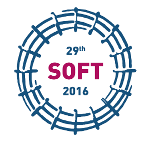Speaker
Zsolt Vizvary
(CCFE)
Description
The ITER first mirrors are the components of optical diagnostic systems closest to the plasma. Deposition may build up on the surfaces of the mirror affecting their ability to fulfil their function. However, physics modelling of this layer growth is fraught with uncertainty. A new experiment is underway on JET, under contract to ITER, with primary objective to test if, under realistic plasma and wall material conditions and with ITER-like first mirror aperture geometry, deposits do grow on first mirrors. This paper describes the engineering design and analysis of this mirror test assembly.
The layout of the mirror assembly is dictated by the ITER requirements, with the directions of the aperture cones and the pinhole sizes are chosen to be ITER relevant.
The only available in-vessel supports for this assembly are welded mounting brackets no longer used by other deposition/erosion diagnostics. Tests on mock-ups and calculations define the maximum load these brackets can take.
The mirrors are very close to the plasma resulting in conflicting electromagnetic and thermal requirements. The components need to be sufficiently massive to cope with the thermal loads (setting a minimum wall thickness), but at the same time resistive enough to keep the disruption loads within those allowed by the mounting brackets. In addition, installation must be performed fully by Remote Handling only. The design evolved into a three part structure: interface — support — housing-aperture cones. Wall thicknesses were minimized, the housing surfaces are plasma sprayed with alumina and the support shape was also designed minimizing the formation of current loops. The most challenging components to manufacture were the multi-cone apertures. This was not suitable for conventional machining, hence additive manufacturing was used.
The assembly was installed in the 2014-5 shutdown and will be removed in the 2016-17 shutdown.
Co-authors
Anna Widdowson
(CCFE, Abingdon, United Kingdom)
Benoit Bourdel
(Ecole Polytechnique, Route de Saclay, 91120, Palaiseau, France)
Frank Leipold
(Department of Physics, Technical University of Denmark, DK-2800 Kgs. Lyngby, Denmark)
Gregory De Temmerman
(ITER Organization, Route de Vinon-sur-Verdon - CS 90 046 - 13067 St Paul Lez Durance Cedex, France)
Marek Rubel
(Fusion Plasma Physics, Royal Institute of Technology (KTH), 100 44 Stockholm, Sweden)
Norman Lam
(CCFE, Abingdon, United Kingdom)
Richard A Pitts
(ITER Organization, Route de Vinon-sur-Verdon - CS 90 046 - 13067 St Paul Lez Durance Cedex, France)
Roger Reichle
(ITER Organization, Route de Vinon-sur-Verdon - CS 90 046 - 13067 St Paul Lez Durance Cedex, France)
Valeria Riccardo
(CCFE, Abingdon, United Kingdom)
Vaughan Thompson
(CCFE, Abingdon, United Kingdom)
Zsolt Vizvary
(CCFE, Abingdon, United Kingdom)

